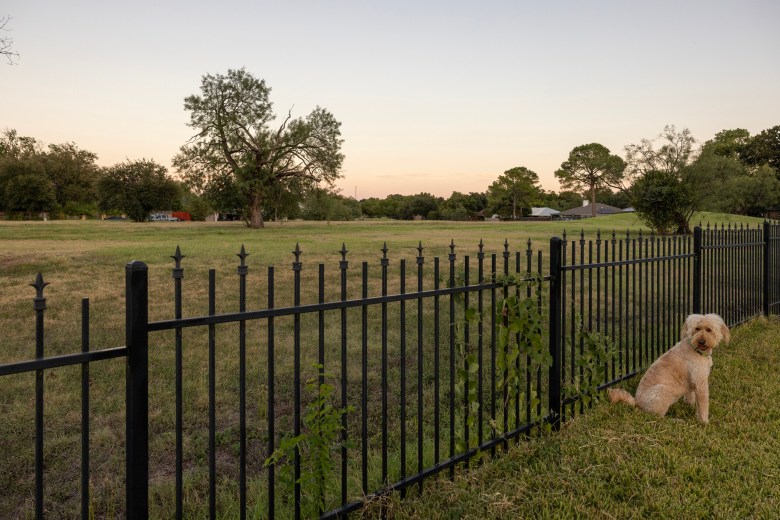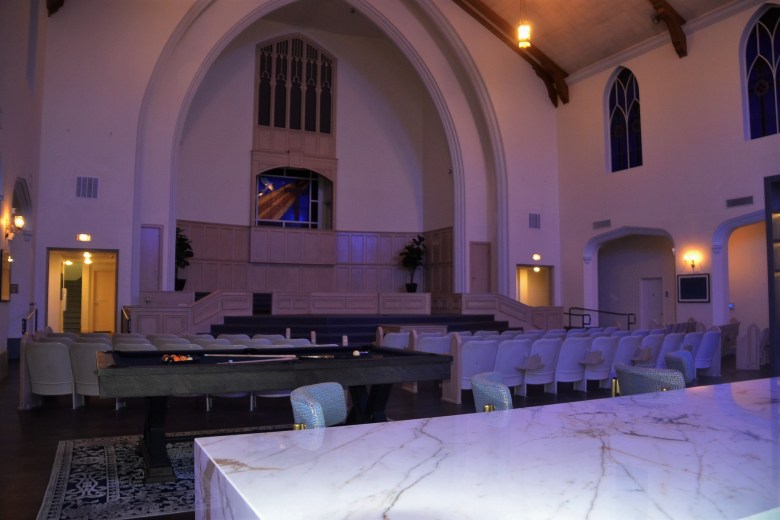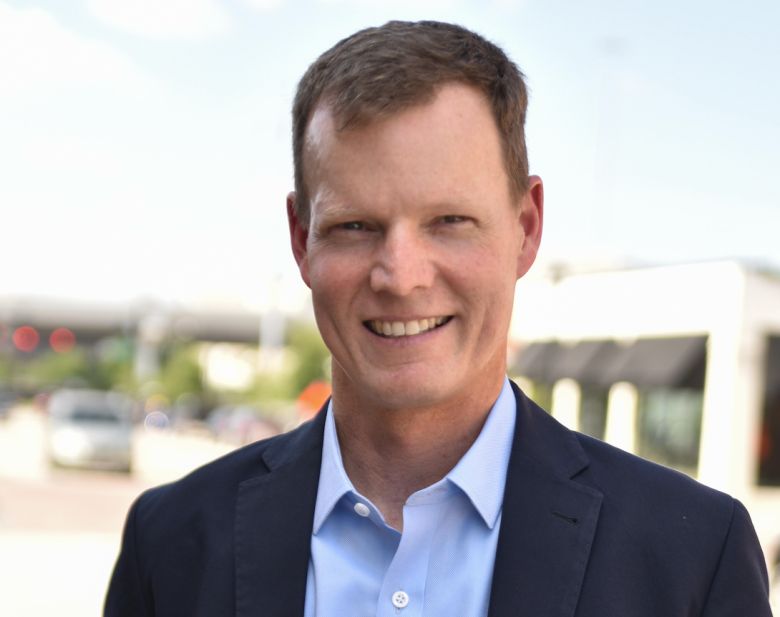Mark Eggebrecht and wife Erica don’t want to be viewed as NIMBY types, but they also want to preserve the tranquility of their home with expansive treetop and sunset views that bely its location minutes off of Interstate 30 in east Fort Worth.
Now, plans for the former Woodhaven Country Club could see housing, including two-story multifamily residences, built onto the defunct golf course’s 10th fairway right behind their modern house.
This is part of the Report’s special 1 Million & Counting growth series, which will be published on Mondays into October. The reporting will lead to a growth summit Oct. 23 at the downtown Tarrant County College Trinity River Campus.
The Eggebrechts, who moved from the Near Southside during COVID to have more room for their two young daughters, say a measure of progress might not be a bad thing for Woodhaven, which hasn’t seen new development in decades.
“But it has to be appropriate,” Mark Eggebrecht said.
Welcome to Fort Worth’s latest dustup over the D-word — density, the push for highly populated and developed areas within the city’s urban core. As fast-growing Cowtown surpassed 1 million residents, multidirectional sprawl persisted — driven by highway access, copious land, relatively inexpensive housing, quality of suburban schools and proximity to job opportunities and the DFW Airport.
But developers’ efforts to fill holes inside Loop 820 often clash with neighbors concerned about the impact on their quality of life and property values. Residents often simultaneously say they want grocery stores and “sit-down” restaurants while opposing the residential rooftops — typically apartments and townhomes — whose residents would support those establishments.
More of these disputes are likely. The city estimates 8,971 acres inside Loop 820 are vacant, or 14.2% of the total land mass. A new Texas law could spur more multifamily housing and mixed-use development in those areas, depending on the desirability of sites, urban planners said, as it gives developers more leeway on such developments without rezoning.
Fort Worth has widely recognized examples where population density mixes with restaurants, retail and other uses, including downtown and the Near Southside. But overall, why does density remain a hard sell in the city?
 Kelly Allen Gray, at home in United Riverside (Scott Nishimura | Fort Worth Report)
Kelly Allen Gray, at home in United Riverside (Scott Nishimura | Fort Worth Report)
Neighborhoods often don’t feel they have enough voice in what’s built, said former City Council member Kelly Allen Gray, whose nine years serving southeast Fort Worth’s District 8 were marked by clashes over infill proposals to put new development in the middle of mature areas.
“You can’t have a city with a million people and no place for them to go,” Gray said. “Density makes sense. But then I also think we have to be thoughtful of (the fact) not everyone wants to live in multifamily.”
Building in the middle of a neighborhood has been much more likely to trigger disputes than doing so at sites that aren’t immediately surrounded by established communities.
“If you’re going to build density right in the middle of a community, do you build six stories, three or four stories?” Gray said. “And then you’re looking down in my backyard as I’m sitting by my pool? That’s kind of creepy when you think about it.”
 The Eggebrechts’ dog sits inside the fence of the family’s Woodhaven Country Club home, which borders the 10th fairway of the defunct golf course. (Maria Crane | Fort Worth Report/CatchLight Local/Report for America)
The Eggebrechts’ dog sits inside the fence of the family’s Woodhaven Country Club home, which borders the 10th fairway of the defunct golf course. (Maria Crane | Fort Worth Report/CatchLight Local/Report for America)
The Woodhaven dispute — the Eggebrechts aren’t alone in their skepticism — has keyed on the multifamily piece of the developer’s plans, which range from single-family to retail and other commercial and agricultural. The City Plan Commission voted Oct. 1 to approve the development’s preliminary layout after hearing hours of debate from homeowners over three meetings.
Opponents, who acknowledge developer Will Northern has engaged in substantial outreach but say he focused on people who favored his development, are now considering litigation to stop it.
They argue the numerous old apartment complexes in Woodhaven are proof enough the neighborhood needs no more multifamily residences. Northern counters that his project will be built-out to today’s much higher standards and that new investment will buoy other multifamily in the area. It’s already prompted some ownership change and reinvestment, he said.
“I hope this project is kicked down the road for years,” Mark Eggebrecht said. “It’s a risky project. It’s a complicated project.”
 After construction of so-called “stealth dorms” proliferated around TCU, the Fort Worth City Council passed an ordinance regulating building occupancy. (Scott Nishimura | Fort Worth Report)
After construction of so-called “stealth dorms” proliferated around TCU, the Fort Worth City Council passed an ordinance regulating building occupancy. (Scott Nishimura | Fort Worth Report)
Grocery on the Near Southside?
While much of the wrangling over infill projects has surfaced in east and southeast Fort Worth, cases elsewhere have also boiled over.
The development of single-family sites into so-called “stealth dorms” around Texas Christian University, for example, led the city to adopt measures limiting the number of unrelated people who could live in houses near campus. Planned apartments on several residential lots along South University Drive near TCU met stiff opposition.
The city’s comprehensive plan calls for more high-density, mixed-use walkable developments close to the city center in areas such as Northside’s Panther Island.
It’s hard to argue against the benefits of thoughtful density partnered with walkable mixed-use environments that complement established neighborhoods, urban planners say. Compared to the cost of bringing public resources to undeveloped, farflung sectors of Fort Worth’s sprawl, building up inside a city’s core allows for more efficient use of streets, police, fire and water, and other public resources, planners say.
It could also create demand for better public schools and public transportation, they say.
 Ann Zadeh (Courtesy photo | Ann Zadeh)
Ann Zadeh (Courtesy photo | Ann Zadeh)
“Financially, it makes more sense for a city (to add) to an area that already has infrastructure,” said Ann Zadeh, an urban planner and former council member representing Fort Worth’s Near Southside, downtown and the West 7th District.
“Even if you have to improve, refresh and redo some of that infrastructure, it’s a bigger return on your investment, as far as the taxes you’re going to garner from that, than allowing low-density sprawl development in an area that doesn’t have the roads and pipes and all those things.”
Zadeh and others cite examples of new mixed-use development in the middle of sensitive neighborhoods that’s worked: the renovation of a church on Race Street in Riverside into the Cielo Place Apartments, the historic Masonic Lodge site in southeast Fort Worth that’s now the mixed-use Renaissance Square, and the Sunset at Fash Place senior living complex on Oakland Boulevard in east Fort Worth.
“We need to show real-life examples,” Zadeh said.
 The Cielo Place Project repurposed the former Riverside Baptist Church sanctuary as a commons area. (Fort Worth Report|Matthew Sgroi)
The Cielo Place Project repurposed the former Riverside Baptist Church sanctuary as a commons area. (Fort Worth Report|Matthew Sgroi)
Fort Worth witnessed the post-World War II expansion of suburban neighborhoods, such as Wedgwood, along the city’s edge that meant a loss of investment and residential growth closer to the core, said Mike Brennan, an urban planner and president of the Near Southside Inc. economic development organization.
Lost businesses, security problems and diminished quality of life followed in the Near Southside, he said. “It all ties back to the number of housing units and design of those units,” he said.
Now, the area’s West Magnolia and South Main districts have filled in with the help of designation by the city as mixed-use urban villages, with toolboxes of financial incentives available to developers and form-based city development codes that promote walkable mixed-use environments.
The revitalized Near Southside has a range of housing, from single-family homes to garage- and small apartments in the middle of neighborhoods such as Fairmount to large multifamily buildings along West Magnolia Avenue and South Main Street to the new 95-unit Bryan Flats super-efficiencies.
Bryan Flats offers small furnished apartments with shared kitchens, laundries and common areas — and no on-site parking — targeted at young renters who like to walk, bike and use public transit. Walkability and connectivity from one neighborhood to another within those districts, is prized.
 A Bryan Flats model apartment. (Courtesy photo | Bryan Flats)
A Bryan Flats model apartment. (Courtesy photo | Bryan Flats)
Brennan said this increased density is moving the Near Southside toward a plum it’s long sought: a grocery store.
The Near Southside doesn’t have sites big enough for the largest supermarkets, but it does have some that can accommodate smaller stores about the size of the Tom Thumb off West 7th Street, he said.
Potential sites include the shopping center at the northeast corner of West Rosedale and Hemphill streets and a historic laundry off of Hemphill. Brennan notes the shopping center’s owner has reinvested in improvements, “and there are tenants there that have leases, so there’s no expectation that’s going to change anytime soon.”
The new life in the Southside — combined with downtown and areas such as Historic Southside and adjacent neighborhoods on East Rosedale east of Interstate 35W — has achieved enough density to support a grocery store, Brennan said.
Still, that would take a public-private partnership with financial incentives, given the likely high cost of acquiring the site and grocery stores’ thin profit margins, he added.
 Mike Brennan (Courtesy photo | Near Southside, Inc.)
Mike Brennan (Courtesy photo | Near Southside, Inc.)
Brennan says he understands many neighborhoods’ wariness toward infill development and feels much of the criticism is well-deserved, given apartment developers’ push several decades ago to build in areas “where they were just an island of apartments and not connected to any sort of activity center.”
“You had this separation of land uses and the apartments … (that) often looked like fortresses with gates around them,” he said.
The state’s new law will allow redevelopment on land that’s already designated for certain commercial uses without going before the city to request zoning changes.
Brennan sees potential for the law to attract developers to some Fort Worth sites, including along South Hemphill Street and Camp Bowie Boulevard.
“That still doesn’t mean that apartment developers are going to just be grabbing property up left and right along these streets,” he said. “They need the sites to be of a certain size, and they need to be thinking that this is a place where people want to live.”
Zadeh views the law — the result of a legislative push to facilitate the development of more affordable workforce housing — as an outgrowth of developers’ collisions with neighborhoods.
“When developers who want to build things constantly get shot down by NIMBY neighbors, they’re going to get to a point where they try another path, and that’s exactly what happened,” she said.
Neighborhoods worry about what the new law could mean. Zadeh shares concerns about what she views as the consistent lack of planning by the city. However, Fort Worth has posted an opening for a chief planning officer, which Zadeh sees as a positive sign.
“Fort Worth kind of has a reputation of being a place that planners don’t want to go because there’s not a whole lot of proactive planning going on,” she said. “But I think we’re at an inflection point where that could change.”
 The historic Butler Place site near downtown Fort Worth is expected to be transformed into a mixed-use development. (Courtesy photo | Fort Worth Housing Solutions)
The historic Butler Place site near downtown Fort Worth is expected to be transformed into a mixed-use development. (Courtesy photo | Fort Worth Housing Solutions)
What next for Butler Place and empty schools?
The historic, isolated 42-acre Butler Place public housing site across from downtown holds potential for redevelopment into a mix of high-density uses.
Fort Worth Housing Solutions, which owns the site, on Sept. 25 announced federal officials gave the go-ahead for the group to reallocate public dollars for Butler’s former 179 subsidized apartments to other properties in the city.
That allows Housing Solutions to move ahead in a study of potential uses it’s conducting with the city of Fort Worth and a consultant.
 Mary-Margaret Lemons (Courtesy photo | Fort Worth Housing Solutions)
Mary-Margaret Lemons (Courtesy photo | Fort Worth Housing Solutions)
“We want to be in lockstep with the city,” Mary-Margaret Lemons, Housing Solutions president, said.
Butler Place is bounded by Interstate 30 on the south, I-35W on the west, and U.S. 287 on the east. Given the site is landlocked and not immediately surrounded by other uses, with the exception of Fort Worth ISD’s I.M. Terrell Academy, access and costs are the biggest challenges to transforming it, planners say.
As part of that process, Lemons said Housing Solutions must work with the city on so-called “entitlements,” such as zoning and platting, which lays out locations and dimensions for parcels, streets and other features.
Financial incentives available to developers also will be in the mix, she said. Lemons sees the redevelopment proceeding in phases over years with an initial draft of plans expected in 2026.
A major goal, besides achieving income the agency will use to fund its programs, will be to “put the majority of that land back on the tax rolls,” she said.
What kind of development could sprout there? She foresees a vibrant mixed-use community, but isn’t being specific yet about the kinds of uses Butler Place could see.
As far as density, “The sky’s the limit,” she said. At the same time, “we want to be responsible and respectful. We don’t want to see a second downtown.”
 Fort Worth ISD is considering the closure of De Zavala Elementary School amid declining enrollment and increasing maintenance costs. The school is featured on the 2025 Fairmount Tour of Historic Homes. (Courtesy photo | Stacy Luecker)
Fort Worth ISD is considering the closure of De Zavala Elementary School amid declining enrollment and increasing maintenance costs. The school is featured on the 2025 Fairmount Tour of Historic Homes. (Courtesy photo | Stacy Luecker)
Meanwhile, in other areas of town, the contracting Fort Worth ISD will close and likely sell some campuses, such as De Zavala Elementary School in Fairmount and the McLean 6th Grade center in the Westcliff-South Hills-Bluebonnet Hills area.
Those sites are likely to draw development interest. Such transactions would have to first negotiate a tangle of restrictions governing sale of a school property.
Zadeh said her Community Design Fort Worth group has offered to help the school district in its discussions about the future of those sites.
“We have old schools and we have old churches that are all in single-family neighborhoods that could be adaptively reused to provide housing and mixed-use walkable (uses) in a really positive way,” she said.
Some community members would love to see those schools repurposed for other civic uses, such as spaces for the arts or even housing for artists, Brennan said.
 Will Northern is preparing the former Woodhaven Country Club, including its golf course, for redevelopment. (Scott Nishimura | Fort Worth Report)
Will Northern is preparing the former Woodhaven Country Club, including its golf course, for redevelopment. (Scott Nishimura | Fort Worth Report)
Back in Woodhaven, Will Northern of Fort Worth’s Crescendo Development, the Woodhaven developer, negotiated his way through the Fort Worth Zoning Commission earlier this year, obtaining zoning for a mix of residential and commercial uses for the country club and golf course. The case bogged down at the City Plan Commission this summer, over his proposed preliminary plat.
The City Plan Commission’s vote frees Northern to begin installing infrastructure and marketing parcels to other developers who specialize in building certain uses, like multifamily, retail and commercial, single-family and agricultural.
Opponents will get another bite of the apple in trying to slow or stop the development. Developers who buy parcels will have to present their proposed site plans and final plats to the Zoning Commission and City Council for approval. Northern told the Report he doesn’t think the controversy will affect his ability to sell the development.
“This development is going to be a catalyst,” he told City Plan commissioners Wednesday.
Scott Nishimura is a senior editor for the Documenters program at the Fort Worth Report. Reach him at scott.nishimura@fortworthreport.org. At the Fort Worth Report, news decisions are made independently of our board members and financial supporters. Read more about our editorial independence policy here.
Related
Fort Worth Report is certified by the Journalism Trust Initiative for adhering to standards for ethical journalism.
Republish This Story
Republishing is free for noncommercial entities. Commercial entities are prohibited without a licensing agreement. Contact us for details.

